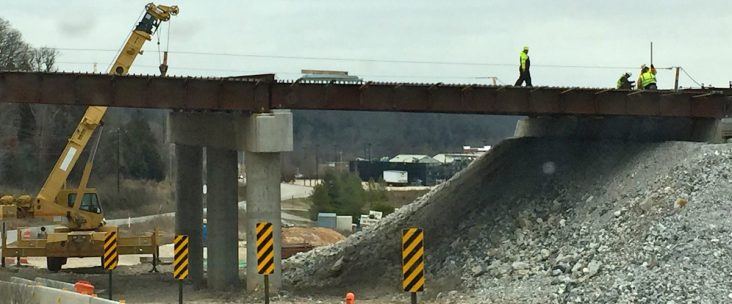Almost nine miles of I-49 through Bentonville and Rogers set for widening construction
by July 6, 2016 1:59 pm 679 views

Another 8.9 miles of Interstate 49 in Bentonville and Rogers is set for widening from four to six lanes as part of more than $66.4 million in work set to begin soon that will require more orange barrels and an unquantifiable amount of driver patience.
Officials with the Arkansas Highway and Transportation Department (AHTD) announced Wednesday (July 6) the awarding of two I-49 widening projects set to begin in the next month with completion scheduled for late 2018.
APAC-Central of Fayetteville received a $38.702 million contract for widening of 5.1 miles of I-49 between Arkansas 264 (the Lowell and Northwest Arkansas Regional Airport exit) and north to New Hope Road in Rogers.
Columbus, Kan.-based Crossland Construction received a $27.738 million contract for the widening of 3.4 miles of I-49 through Bentonville that includes new interchanges at I-49/Arkansas 102 and I-49/Arkansas 72. The Arkansas 102 project, a busy interchange that separates Rogers from Bentonville, has the potential to create the most traffic disruption.
WORK PART OF EXTENSIVE RENOVATION PROGRAM
Highway contracts in conjunction with the I-49 widening through Northwest Arkansas generated more than $41.48 million for construction crews in 2015. Nearly $350 million of highway projects are in the works in Benton and Washington counties, according to state highway officials.
Much of the work is funded by a half-cent sales tax voters passed in 2012. The revenue generated from the tax over 10-years is being used to pay for a four-lane highway system across the state and fund lane expansions to I-49 throughout Benton and Washington counties.
In 2015, there were roughly 30 major road projects underway in the two counties. It is estimated that all work in the region estimated for completion by 2019 will cost more than $698 million, according to Dick Trammel, a member of the Arkansas Highway Commission who lives in Northwest Arkansas.
The most extensive project is the much-needed widening of the I-49 corridor that links the region to the rest of the state and country. The I-49 corridor widening involves different projects – including interchanges – slated through 2017 for a total price tag of $605 million, according to Trammel. In 2014, four projects were completed at a cost of $40 million. Seven others began in 2015 with a cost of $110 million, with 14 other projects on tap for an estimated $455 million.
According to AHTD info, there are now 9.7 miles of I-49 under some phase of construction in Benton County, with the work valued at $78.4 million. There are 27 miles of I-49 under construction in Washington County with a combined contract value of $64.1 million.
POPULATION GROWTH FEEDING NEED FOR ROAD WORK
For several years the four-lane I-49 through Benton and Washington counties has not been enough to handle the rise in traffic volume produced by a fast-growing metro population.
U.S. Census estimate updates released March 24 show that the Northwest Arkansas metro area accounted for most of the state’s population growth in the past five years, and only 35 of the nation’s 381 metro areas posted a higher population gain in the past five years than Northwest Arkansas.
The Northwest Arkansas metro – home to corporate giants Wal-Mart Stores Inc, Tyson Foods, and J.B. Hunt Transport, as well as the University of Arkansas – had population growth of 50,532 between April 2010 and July 1, 2015, according to updated Census data. During the past year (July 1, 2014 – July 1, 2015), the region’s population grew by 11,495.
“The latest Census estimates show Northwest Arkansas grew by more than 31 people per day from July 2014 to July 2015. That’s a solid increase because our average day between the April 2010 Census and the July 2014 estimate brought us about 25 new people,” Rob Smith, communications and policy director with the Northwest Arkansas Council, said following the March update.
Following are the 2014 population estimates for seven metro areas primarily in Arkansas: Central Arkansas, 729,135; Northwest Arkansas, 501,563; Fort Smith, 279,592; Texarkana, 149,235; Jonesboro, 126,764; Pine Bluff, 94,716; and Hot Springs, 97,322.
Central Arkansas, the state’s largest metro by population, had five year growth of 31,789, and year-over-year growth of 2,652.
